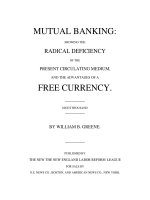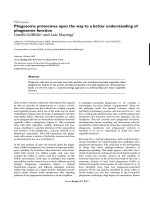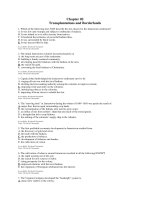Poor economics a radical rethinking of the way to fight global poverty
Bạn đang xem bản rút gọn của tài liệu. Xem và tải ngay bản đầy đủ của tài liệu tại đây (7.06 MB, 302 trang )
TableofContents
TitlePage
Dedication
Foreword
Chapter1-ThinkAgain,Again
TRAPPEDINPOVERTY?
PARTI-PrivateLives
Chapter2-ABillionHungryPeople?
ARETHEREREALLYABILLIONHUNGRYPEOPLE?
ARETHEPOORREALLYEATINGWELL,ANDEATINGENOUGH?
WHYDOTHEPOOREATSOLITTLE?
SOISTHEREREALLYANUTRITION-BASEDPOVERTYTRAP?
Chapter3-Low-HangingFruitforBetter(Global)Health?
THEHEALTHTRAP
WHYAREN’TTHESETECHNOLOGIESUSEDMORE?
UNDERSTANDINGHEALTH-SEEKINGBEHAVIOR
THEVIEWFROMOURCOUCH
Chapter4-TopoftheClass
SUPPLY-DEMANDWARS
THECURSEOFEXPECTATIONS
WHYSCHOOLSFAIL
REENGINEERINGEDUCATION
Chapter5-PakSudarno’sBigFamily
WHATISWRONGWITHLARGEFAMILIES?
DOTHEPOORCONTROLTHEIRFERTILITYDECISIONS?
CHILDRENASFINANCIALINSTRUMENTS
THEFAMILY
PARTII-Institutions
Chapter6-BarefootHedge-FundManagers
THEHAZARDSOFBEINGPOOR
THEHEDGE
WHEREARETHEINSURANCECOMPANIESFORTHEPOOR?
Chapter7-TheMenfromKabulandtheEunuchsofIndia:The(NotSo)Simple
...
LENDINGTOTHEPOOR
MICROINSIGHTSFORAMACROPROGRAM
DOESMICROCREDITWORK?
THELIMITSOFMICROCREDIT
HOWCANLARGERFIRMSBEFINANCED?
Chapter8-SavingBrickbyBrick
WHYTHEPOORDON’TSAVEMORE
THEPSYCHOLOGYOFSAVINGS
POVERTYANDTHELOGICOFSELF-CONTROL
Chapter9-ReluctantEntrepreneurs
CAPITALISTSWITHOUTCAPITAL
THEBUSINESSESOFTHEPOOR
GOODJOBS
Chapter10-Policies,Politics
POLITICALECONOMY
CHANGESATTHEMARGIN
DECENTRALIZATIONANDDEMOCRACYINPRACTICE
AGAINSTPOLITICALECONOMY
InPlaceofaSweepingConclusion
Acknowledgements
Notes
Index
CopyrightPage
Forourmothers,
NirmalaBanerjeeand
ViolaineDuflo
Foreword
Esther was six when she read in a comic book on Mother Teresa that the city
thencalledCalcuttawassocrowdedthateachpersonhadonly10squarefeetto
livein.Shehadavisionofavastcheckerboardofacity,with3feetby3feet
markedoutontheground,eachwithahumanpawn,asitwere,huddledintoit.
Shewonderedwhatshecoulddoaboutit.
WhenshefinallyvisitedCalcutta,shewastwenty-fourandagraduatestudent
at MIT. Looking out of the taxi on her way to the city, she felt vaguely
disappointed;everywhereshelooked,therewasemptyspace—trees,patchesof
grass, empty sidewalks. Where was all the misery so vividly depicted in the
comicbook?Wherehadallthepeoplegone?
At six, Abhijit knew where the poor lived. They lived in little ramshackle
housesbehindhishomeinCalcutta.Theirchildrenalwaysseemedtohavelots
of time to play, and they could beat him at any sport: When he went down to
playmarbleswiththem,themarbleswouldalwaysendupinthepocketsoftheir
raggedshorts.Hewasjealous.
Thisurgetoreducethepoortoasetofclichéshasbeenwithusforaslongas
therehasbeenpoverty:Thepoorappear,insocialtheoryasmuchasinliterature,
byturnslazyorenterprising,nobleorthievish,angryorpassive,helplessorselfsufficient.Itisnosurprisethatthepolicystancesthatcorrespondtotheseviews
of the poor also tend to be captured in simple formulas: “Free markets for the
poor,”“Makehumanrightssubstantial,”“Dealwithconflictfirst,”“Givemore
money to the poorest,” “Foreign aid kills development,” and the like. These
ideasallhaveimportantelementsoftruth,buttheyrarelyhavemuchspacefor
average poor women or men, with their hopes and doubts, limitations and
aspirations, beliefs and confusion. If the poor appear at all, it is usually as the
dramatispersonaeofsomeupliftinganecdoteortragicepisode,tobeadmiredor
pitied, but not as a source of knowledge, not as people to be consulted about
whattheythinkorwantordo.
All too often, the economics of poverty gets mistaken for poor economics:
Because the poor possess very little, it is assumed that there is nothing
interestingabouttheireconomicexistence.Unfortunately,thismisunderstanding
severely undermines the fight against global poverty: Simple problems beget
simplesolutions.Thefieldofanti-povertypolicyislitteredwiththedetritusof
instant miracles that proved less than miraculous. To progress, we have to
abandonthehabitofreducingthepoortocartooncharactersandtakethetimeto
really understand their lives, in all their complexity and richness. For the past
fifteenyears,wehavetriedtodojustthat.
Weareacademics,andlikemostacademicsweformulatetheoriesandstareat
data. But the nature of the work we do has meant that we have also spent
months, spread over many years, on the ground working with NGO
(nongovernmental organization) activists and government bureaucrats, health
workers and microlenders. This has taken us to the back alleys and villages
where the poor live, asking questions, looking for data. This book would not
have been written but for the kindness of the people we met there. We were
alwaystreatedasguestseventhough,moreoftenthannot,wehadjustwalked
in. Our questions were answered with patience, even when they made little
sense;manystoriesweresharedwithus.1
Back in our offices, remembering these stories and analyzing the data, we
werebothfascinatedand confused, strugglingtofit whatwe werehearing and
seeing into the simple models that (often Western or Western-trained)
professionaldevelopmenteconomistsandpolicymakershavetraditionallyused
to think about the lives of the poor. More often than not, the weight of the
evidenceforcedustoreassessorevenabandonthetheoriesthatwebroughtwith
us.Butwetriednottodosobeforeweunderstoodexactlywhytheywerefailing
andhowtoadaptthemtobetterdescribetheworld.Thisbookcomesoutofthat
interchange; it represents our attempt to knit together a coherent story of how
poorpeoplelivetheirlives.
Our focus is on the world’s poorest. The average poverty line in the fifty
countries where most of the poor live is 16 Indian rupees per person per day.2
Peoplewholiveonlessthanthatareconsideredtobepoorbythegovernmentof
their own countries.Atthecurrentexchangerate, 16rupeescorrespondsto36
U.S. cents. But because prices are lower in most developing countries, if the
pooractuallyboughtthethingstheydoatU.S.prices,theywouldneedtospend
more—99cents.Sotoimaginethelivesofthepoor,youhavetoimaginehaving
toliveinMiamiorModestowith99centsperdayforalmostallyoureveryday
needs(excludinghousing).Itisnoteasy—inIndia,forexample,theequivalent
amount would buy you fifteen smallish bananas, or about 3 pounds of lowquality rice. Can one live on that? And yet, around the world, in 2005, 865
millionpeople(13percentoftheworld’spopulation)did.
Whatisstrikingisthatevenpeoplewhoarethatpoorarejustliketherestof
usinalmosteveryway.Wehavethesamedesiresandweaknesses;thepoorare
no less rational than anyone else—quite the contrary. Precisely because they
havesolittle,weoftenfindthemputtingmuchcarefulthoughtintotheirchoices:
They have to be sophisticated economists just to survive. Yet our lives are as
differentasliquorandliquorice.Andthishasalottodowithaspectsofourown
livesthatwetakeforgrantedandhardlythinkabout.
Living on 99 cents a day means you have limited access to information—
newspapers,television,andbooksallcostmoney—andsoyouoftenjustdon’t
know certain facts that the rest of the world takes as given, like, for example,
that vaccines can stop your child from getting measles. It means living in a
worldwhoseinstitutionsarenotbuiltforsomeonelikeyou.Mostofthepoordo
nothaveasalary,letalonearetirementplanthatdeductsautomaticallyfromit.It
means making decisionsaboutthingsthatcomewithalotofsmallprintwhen
youcannotevenproperlyreadthelargeprint.Whatdoessomeonewhocannot
read make of a health insurance product that doesn’t cover a lot of
unpronounceablediseases?Itmeansgoingtovotewhenyourentireexperience
of the political system is a lot of promises, not delivered; and not having
anywhere safe to keep your money, because what the bank manager can make
fromyourlittlesavingswon’tcoverhiscostofhandlingit.Andsoon.
Allthisimpliesthatmakingthemostoftheirtalentandsecuringtheirfamily’s
futuretakethatmuchmoreskill,willpower,andcommitmentforthepoor.And
conversely,thesmallcosts,thesmallbarriers,andthesmallmistakesthatmost
ofusdonotthinktwiceaboutloomlargeintheirlives.
Itisnoteasytoescapefrompoverty,butasenseofpossibilityandalittlebit
ofwell-targetedhelp(apieceofinformation,alittlenudge)cansometimeshave
surprisinglylargeeffects.Ontheotherhand,misplacedexpectations,thelackof
faithwhereitisneeded,andseeminglyminorhurdlescanbedevastating.Apush
on the right lever can make a huge difference, but it is often difficult to know
where that lever is. Above all, it is clear that no single lever will solve every
problem.
Poor Economics isabook abouttheveryricheconomicsthatemergesfrom
understanding the economic lives of the poor. It is a book about the kinds of
theoriesthathelpusmakesenseofbothwhatthepoorareabletoachieve,and
whereandforwhatreasontheyneedapush.Eachchapterinthisbookdescribes
a search to discover what these sticking points are, and how they can be
overcome.Weopenwiththeessentialaspectsofpeople’sfamilylives:whatthey
buy;whattheydoabouttheirchildren’sschooling,theirownhealth,orthatof
their children or parents; how many children they choose to have; and so on.
Thenwegoontodescribehowmarketsandinstitutionsworkforthepoor:Can
they borrow, save, insure themselves against the risks they face? What do
governments do for them, and when do they fail them? Throughout, the book
returnstothesamebasicquestions.Aretherewaysforthepoortoimprovetheir
lives,andwhatispreventingthemfrombeingabletodothesethings?Isitmore
the cost of getting started, or is it easy to get started but harder to continue?
Whatmakesitcostly?Dopeoplesensethenatureofthebenefits?Ifnot,what
makesithardforthemtolearnthem?
PoorEconomicsisultimatelyaboutwhatthelivesandchoicesofthepoortell
usabouthowtofightglobalpoverty.Ithelpsusunderstand,forexample,why
microfinanceisusefulwithoutbeingthemiraclesomehopeditwouldbe;why
thepooroftenendupwithhealthcarethatdoesthemmoreharmthangood;why
childrenofthepoorcangotoschoolyearafteryearandnotlearnanything;why
thepoordon’twanthealthinsurance.Anditrevealswhysomanymagicbullets
of yesterday have ended up as today’s failed ideas. The book also tells a lot
aboutwherehopelies:whytokensubsidiesmighthavemorethantokeneffects;
howtobettermarketinsurance;whylessmaybemoreineducation;whygood
jobs matter for growth. Above all, it makes clear why hope is vital and
knowledge critical, why we have to keep on trying even when the challenge
looksoverwhelming.Successisn’talwaysasfarawayasitlooks.
1
ThinkAgain,Again
Everyyear,9millionchildrendiebeforetheirfifthbirthday.1AwomaninsubSaharan Africa has a one-in-thirty chance of dying while giving birth—in the
developed world, the chance is one in 5,600. There are at least twenty-five
countries, most of them in sub-Saharan Africa, where the average person is
expected to live no more than fifty-five years. In India alone, more than 50
millionschool-goingchildrencannotreadaverysimpletext.2
Thisisthekindofparagraphthatmightmakeyouwanttoshutthisbookand,
ideally, forget about this whole business of world poverty: The problem seems
toobig,toointractable.Ourgoalwiththisbookistopersuadeyounotto.
A recent experiment at the University of Pennsylvania illustrates well how
easilywecanfeeloverwhelmedbythemagnitudeoftheproblem.3Researchers
gavestudents$5tofilloutashortsurvey.Theythenshowedthemaflyerand
askedthemtomakeadonationtoSavetheChildren,oneoftheworld’sleading
charities. There were two different flyers. Some (randomly selected) students
wereshownthis:
FoodshortagesinMalawiareaffectingmorethan3millionchildren;In
Zambia, severe rainfall deficits have resulted in a 42% drop in maize
productionfrom2000.Asaresult,anestimated3millionZambiansface
hunger;FourmillionAngolans—onethirdofthepopulation—havebeen
forcedtofleetheirhomes;Morethan11millionpeopleinEthiopianeed
immediatefoodassistance.
Otherstudentswereshownaflyerfeaturingapictureofayounggirlandthese
words:
Rokia,a7-year-oldgirlfromMali,Africa,isdesperatelypoorandfacesa
threat of severe hunger or even starvation. Her life will be changed for
the better as a result of your financial gift. With your support, and the
support of other caring sponsors, Save the Children will work with
Rokia’s family and other members of the community to help feed her,
provide her with education, as well as basic medical care and hygiene
education.
Thefirstflyerraisedanaverageof$1.16fromeachstudent.Thesecondflyer,
in which the plight of millions became the plight of one, raised $2.83. The
students, it seems, were willing to take some responsibility for helping Rokia,
butwhenfacedwiththescaleoftheglobalproblem,theyfeltdiscouraged.
Someotherstudents,alsochosenatrandom,wereshownthesametwoflyers
after being told that people are more likely to donate money to an identifiable
victim than when presented with general information. Those shown the first
flyer,forZambia,Angola,andMali,gavemoreorlesswhatthatflyerhadraised
withoutthewarning—$1.26.Thoseshownthesecondflyer,forRokia,afterthis
warninggaveonly$1.36,lessthanhalfofwhattheircolleagueshadcommitted
without it. Encouraging students to think again prompted them to be less
generoustoRokia,butnotmoregeneroustoeveryoneelseinMali.
The students’ reaction is typical of how most of us feel when we are
confronted with problems like poverty. Our first instinct is to be generous,
especially when facing an imperiled seven-year-old girl. But, like the Penn
students, our second thought is often that there is really no point: Our
contributionwouldbeadropinthebucket,andthebucketprobablyleaks.This
bookisaninvitationtothinkagain,again:toturnawayfromthefeelingthatthe
fightagainstpovertyistoooverwhelming,andtostarttothinkofthechallenge
asasetofconcreteproblemsthat,onceproperlyidentifiedandunderstood,can
besolvedoneatatime.
Unfortunately, this is not how the debates on poverty are usually framed.
Instead of discussing how best to fight diarrhea or dengue, many of the most
vocal experts tend to be fixated on the “big questions”: What is the ultimate
cause of poverty? How much faith should we place in free markets? Is
democracygoodforthepoor?Doesforeignaidhavearoletoplay?Andsoon.
JeffreySachs,advisertotheUnitedNations,directoroftheEarthInstituteat
ColumbiaUniversityinNewYorkCity,andonesuchexpert,hasananswerto
all these questions: Poor countries are poor because they are hot, infertile,
malariainfested,oftenlandlocked;thismakesithardforthemtobeproductive
without an initial large investment to help them deal with these endemic
problems. But they cannot pay for the investments precisely because they are
poor—theyareinwhateconomistscalla“povertytrap.”Untilsomethingisdone
abouttheseproblems,neitherfreemarketsnordemocracywilldoverymuchfor
them.Thisiswhyforeignaidiskey:Itcankick-startavirtuouscyclebyhelping
poorcountriesinvestinthesecriticalareasandmakethemmoreproductive.The
resultinghigherincomeswillgeneratefurtherinvestments;thebeneficialspiral
willcontinue.Inhisbest-selling2005book,TheEndofPoverty,4Sachsargues
thatiftherichworldhadcommitted$195billioninforeignaidperyearbetween
2005and2025,povertycouldhavebeenentirelyeliminatedbytheendofthis
period.
But then there are others, equally vocal, who believe that all of Sachs’s
answers are wrong. William Easterly, who battles Sachs from New York
UniversityattheotherendofManhattan,hasbecomeoneofthemostinfluential
anti-aid public figures, following the publication of two books, The Elusive
QuestforGrowthandTheWhiteMan’sBurden.5DambisaMoyo,aneconomist
whopreviouslyworkedatGoldmanSachsandattheWorldBank,hasjoinedher
voice to Easterly’s with her recent book, DeadAid.6 Both argue that aid does
morebadthangood:Itpreventspeoplefromsearchingfortheirownsolutions,
while corrupting and undermining local institutions and creating a selfperpetuatinglobbyofaidagencies.Thebestbetforpoorcountriesistorelyon
onesimpleidea:Whenmarketsarefreeandtheincentivesareright,peoplecan
findwaystosolvetheirproblems.Theydonotneedhandouts,fromforeigners
or from their own governments. In this sense, the aid pessimists are actually
quiteoptimisticaboutthewaytheworldworks.AccordingtoEasterly,thereare
nosuchthingsaspovertytraps.
Whomshouldwebelieve?Thosewhotellusthataidcansolvetheproblem?
Orthosewhosaythatitmakesthingsworse?Thedebatecannotbesolvedinthe
abstract:Weneedevidence.Butunfortunately,thekindofdatausuallyusedto
answerthebigquestionsdoesnotinspireconfidence.Thereisneverashortage
ofcompellinganecdotes,anditisalwayspossibletofindatleastonetosupport
any position. Rwanda, for example, received a lot of aid money in the years
immediately after the genocide, and prospered. Now that the economy is
thriving,PresidentPaulKagamehasstartedtoweanthecountryoffaid.Should
wecountRwandaasanexampleofthegoodthataidcando(asSachssuggests),
orasaposterchildforself-reliance(asMoyopresentsit)?Orboth?
Because individual examples like Rwanda cannot be pinned down, most
researcherstryingtoanswerthebigphilosophicalquestionsprefermulticountry
comparisons. For example, the data on a couple of hundred countries in the
worldshowthatthosethatreceivedmoreaiddidnotgrowfasterthantherest.
Thisisofteninterpretedasevidencethataiddoesnotwork,butinfact,itcould
alsomeantheopposite.Perhapstheaidhelpedthemavoidamajordisaster,and
thingswouldhavebeenmuchworsewithoutit.Wesimplydonotknow;weare
justspeculatingonagrandscale.
Butifthereisreallynoevidencefororagainstaid,whatarewesupposedtodo
—giveuponthepoor?Fortunately,wedon’tneedtobequitesodefeatist.There
are in fact answers—indeed, this whole book is in the form of an extended
answer—itisjustthattheyarenotthekindofsweepinganswersthatSachsand
Easterlyfavor.Thisbookwillnottellyouwhetheraidisgoodorbad,butitwill
say whether particular instances of aid did some good or not. We cannot
pronounceontheefficacyofdemocracy,butwedohavesomethingtosayabout
whetherdemocracycouldbemademoreeffectiveinruralIndonesiabychanging
thewayitisorganizedonthegroundandsoon.
In any case, it is not clear that answering some of these big questions, like
whetherforeignaidworks,isasimportantaswearesometimesledtobelieve.
Aid looms large for those in London, Paris, or Washington, DC, who are
passionateabouthelpingthepoor(andthoselesspassionate,whoresentpaying
forit).Butintruth,aidisonlyaverysmallpartofthemoneythatisspentonthe
poor every year. Most programs targeted at the world’s poor are funded out of
theircountry’sownresources.India,forexample,receivesessentiallynoaid.In
2004–2005, it spent half a trillion rupees ($31 billion USD PPP)7 just on
primary-educationprogramsforthepoor.EveninAfrica,whereforeignaidhas
amuchmoreimportantrole,itrepresentedonly5.7percentoftotalgovernment
budgets in 2003 (12 percent if we exclude Nigeria and South Africa, two big
countriesthatreceiveverylittleaid).8
Moreimportant,theendlessdebatesabouttherightsandwrongsofaidoften
obscure what really matters: not so much where the money comes from, but
where it goes. This is a matter of choosing the right kind of project to fund—
should it be food for the indigent, pensions for the elderly, or clinics for the
ailing?—and then figuring out how best to run it. Clinics, for example, can be
runandstaffedinmanydifferentways.
Nooneintheaiddebatereallydisagreeswiththebasicpremisethatweshould
helpthepoorwhenwecan.Thisisnosurprise.ThephilosopherPeterSingerhas
writtenaboutthemoralimperativetosavethelivesofthosewedon’tknow.He
observes that most people would willingly sacrifice a $1,000 suit to rescue a
child seen drowning in a pond9 and argues that there should be no difference
between that drowning child and the 9 million children who, every year, die
beforetheirfifthbirthday.ManypeoplewouldalsoagreewithAmartyaSen,the
economist-philosopher and Nobel Prize Laureate, that poverty leads to an
intolerablewasteoftalent.Asheputsit,povertyisnotjustalackofmoney;itis
not having the capability to realize one’s full potential as a human being.10 A
poorgirlfromAfricawillprobablygotoschoolforatmostafewyearsevenif
she is brilliant, and most likely won’t get the nutrition to be the world-class
athlete she might have been, or the funds to start a business if she has a great
idea.
It is true that this wasted life probably does not directly affect people in the
developedworld,butitisnotimpossiblethatitmight:Shemightendupasan
HIV-positive prostitute who infects a traveling American who then brings the
disease home,or shemightdevelopastrainofantibiotic-resistantTBthatwill
eventuallyfinditswaytoEurope.Hadshegonetoschool,shemighthaveturned
outtobethepersonwhoinventedthecureforAlzheimer’s.Orperhaps,likeDai
Manju,aChineseteenagerwhogottogotoschoolbecauseofaclericalerrorat
a bank, she would end up as a business tycoon employing thousands of others
(NicholasKristofandSherylWuDunntellherstoryintheirbookHalftheSky).11
Andevenifshedoesn’t,whatcouldjustifynotgivingherachance?
Themaindisagreementshowsupwhenweturntothequestion,“Doweknow
of effective ways to help the poor?” Implicit in Singer’s argument for helping
othersistheideathatyouknowhowtodoit:Themoralimperativetoruinyour
suitismuchlesscompellingifyoudonotknowhowtoswim.Thisiswhy,in
The Life You Can Save, Singer takes the trouble to offer his readers a list of
concrete examples of things that they should support, regularly updated on his
Website.12KristofandWuDunndothesame.Thepointissimple:Talkingabout
theproblemsoftheworldwithouttalkingaboutsomeaccessiblesolutionsisthe
waytoparalysisratherthanprogress.
Thisiswhyitisreallyhelpfultothinkintermsofconcreteproblemswhich
canhavespecificanswers,ratherthanforeignassistanceingeneral:“aid”rather
than “Aid.” To take an example, according to the World Health Organization
(WHO),malariacausedalmost1milliondeathsin2008,mostlyamongAfrican
children.13Onethingweknowisthatsleepingunderinsecticide-treatedbednets
can help save many of these lives. Studies have shown that in areas where
malaria infection is common, sleeping under an insecticide-treated bed net
reducestheincidenceofmalariabyhalf.14What,then,isthebestwaytomake
surethatchildrensleepunderbednets?
Forapproximately$10,youcandeliveraninsecticide-treatednettoafamily
andteachthehouseholdhowtouseit.ShouldthegovernmentoranNGOgive
parents free bed nets, or ask them to buy their own, perhaps at a subsidized
price?Orshouldweletthembuyitinthemarketatfullprice?Thesequestions
canbeanswered,buttheanswersarebynomeansobvious.Yetmany“experts”
takestrongpositionsonthemthathavelittletodowithevidence.
Because malaria is contagious, if Mary sleeps under a bed net, John is less
likelytogetmalaria—ifatleasthalfthepopulationsleepsunderanet,theneven
thosewhodonothavemuchlessriskofgettinginfected. 15Theproblemisthat
fewer than one-fourth of kids at risk sleep under a net:16 It looks like the $10
costistoomuchformanyfamiliesinMaliorKenya.Giventhebenefitsbothto
the user and others in the neighborhood, selling the nets at a discount or even
giving them away would seem to be a good idea. Indeed, free bed-net
distributionisonethingthatJeffreySachsadvocates.EasterlyandMoyoobject,
arguing that people will not value (and hence will not use) the nets if they get
them for free. And even if they do, they may become used to handouts and
refuse to buy more nets in the future, when they are not free, or refuse to buy
other things that they need unless these are also subsidized. This could wreck
well-functioning markets. Moyo tells the story of how a bed-net supplier was
ruined by a free bed-net distribution program. When free distribution stopped,
therewasnoonetosupplybednetsatanyprice.
To shed light on this debate, we need to answer three questions. First, if
peoplemustpayfullprice(oratleastasignificantfractionoftheprice)forabed
net,willtheyprefertogowithout?Second,ifbednetsaregiventothemfreeor
at some subsidized price, will people use them, or will they be wasted? Third,
after getting the net at subsidized price once, will they become more or less
willingtopayforthenextoneifthesubsidiesarereducedinthefuture?
To answer these questions, we would need to observe the behavior of
comparable groups of people facing different levels of subsidy. The key word
hereis“comparable.”Peoplewhopayforbednetsandpeoplewhogetthemfor
freeareusuallynotgoingtobealike:Itispossiblethatthosewhopaidfortheir
netswillbericherandbettereducated,andhaveabetterunderstandingofwhy
theyneedabednet;thosewhogotthemforfreemighthavebeenchosenbyan
NGO precisely because they were poor. But there could also be the opposite
pattern:Thosewhogotthemforfreearethewellconnected,whereasthepoor
and isolated had to pay full price. Either way, we cannot draw any conclusion
fromthewaytheyusedtheirnet.
For this reason, the cleanest way to answer such questions is to mimic the
randomizedtrialsthatareusedinmedicinetoevaluatetheeffectivenessofnew
drugs.PascalineDupas,oftheUniversityofCaliforniaatLosAngeles,carried
out such an experiment in Kenya, and others followed suit with similar
experiments in Uganda and Madagascar. 17 In Dupas’s experiment, individuals
were randomly selected to receive different levels of subsidy to purchase bed
nets. By comparing the behavior of randomly selected equivalent groups that
were offered a net at different prices, she was able to answer all three of our
questions,atleastinthecontextinwhichtheexperimentwascarriedout.
In Chapter 3 of this book, we will have a lot to say about what she found.
Although open questions remain (the experiments do not yet tell us about
whetherthedistributionofsubsidizedimportedbednetshurtlocalproducers,for
example), these findings did a lot to move this debate and influenced both the
discourseandthedirectionofpolicy.
The shift from broad general questions to much narrower ones has another
advantage.Whenwelearnaboutwhetherpoorpeoplearewillingtopaymoney
forbednets,andwhethertheyusethemiftheygetthemforfree,welearnabout
muchmorethanthebestwaytodistributebednets:Westarttounderstandhow
poor people make decisions. For example, what stands in the way of more
widespread bed net adoption? It could be a lack of information about their
benefits,orthefactthatpoorpeoplecannotaffordthem.Itcouldalsobethatthe
poor are so absorbed by the problems of the present that they don’t have the
mental space to worry about the future, or there could be something entirely
different going on. Answering these questions, we get to understand what, if
anything,isspecialaboutthepoor:Dotheyjustlivelikeeveryoneelse,except
withlessmoney,oristheresomethingfundamentallydifferentaboutlifeunder
extremepoverty?Andifitissomethingspecial,isitsomethingthatcouldkeep
thepoortrappedinpoverty?
TRAPPEDINPOVERTY?
It is no accident that Sachs and Easterly have radically opposite views on
whether bed nets should be sold or given away. The positions that most rich-
countryexpertstakeonissuesrelatedtodevelopmentaidorpovertytendtobe
colored by their specific worldviews even when there seem to be, as with the
price of the bed nets, concrete questions that should have precise answers. To
caricatureeversoslightly,ontheleftofthepoliticalspectrum,JeffSachs(along
with the UN, the World Health Organization, and a good part of the aid
establishment) wants to spend more on aid, and generally believes that things
(fertilizer,bednets,computersinschool,andsoon)shouldbegivenawayand
thatpoorpeopleshouldbeenticedtodowhatwe(orSachs,ortheUN)thinkis
good for them: For example, children should be given meals at school to
encouragetheirparentstosendthemtoschoolregularly.Ontheright,Easterly,
along with Moyo, the American Enterprise Institute, and many others, oppose
aid,notonlybecauseitcorruptsgovernmentsbutalsobecauseatamorebasic
level,theybelievethatweshouldrespectpeople’sfreedom—iftheydon’twant
something,thereisnopointinforcingituponthem:Ifchildrendonotwantto
gotoschoolitmustbebecausethereisnopointingettingeducated.
These positions are not just knee-jerk ideological reactions. Sachs and
Easterlyarebotheconomists,andtheirdifferences,toalargeextent,stemfroma
different answer to an economic question: Is it possible to get trapped in
poverty?Sachs,weknow,believesthatsomecountries,becauseofgeographyor
badluck,aretrappedinpoverty:Theyarepoorbecausetheyarepoor.Theyhave
thepotentialtobecomerichbuttheyneedtobedislodgedfromwheretheyare
stuckandsetonthewaytoprosperity,henceSachs’semphasisononebigpush.
Easterly,bycontrast,pointsoutthatmanycountriesthatusedtobepoorarenow
rich,andviceversa.Iftheconditionofpovertyisnotpermanent,heargues,then
theideaofapovertytrapthatinexorablyensnarespoorcountriesisbogus.
The same question could also be asked about individuals. Can people be
trappedinpoverty?Ifthiswerethecase,aonetimeinfusionofaidcouldmakea
huge difference to a person’s life, setting her on a new trajectory. This is the
underlyingphilosophybehindJeffreySachs’sMillenniumVillagesProject.The
villagersinthefortunatevillagesgetfreefertilizer,schoolmeals,workinghealth
clinics, computers in their school, and much more. Total cost: half a million
dollarsayearpervillage.Thehope,accordingtotheproject’sWebsite,isthat
“Millennium Village economies can transition over a period from subsistence
farmingtoself-sustainingcommercialactivity.”18
OnavideotheyproducedforMTV,JeffreySachsandactressAngelinaJolie
visited Sauri, in Kenya, one of the oldest millennium villages. There they met
Kennedy, a young farmer. He was given free fertilizer, and as a result, the
harvestfromhisfieldwastwentytimeswhatithadbeeninpreviousyears.With
thesavingsfromthatharvest,thevideoconcluded,hewouldbeabletosupport
himselfforever.TheimplicitargumentwasthatKennedywasinapovertytrap
inwhichhecouldnotaffordfertilizer:Thegiftoffertilizerfreedhim.Itwasthe
onlywayhecouldescapefromthetrap.
But, skeptics could object that if fertilizer is really so profitable, why could
Kennedynothaveboughtjustalittlebitofitandputitonthemostsuitablepart
of his field? This would have raised the yield, and with the extra money
generated, he could have bought more fertilizer the following year, and so on.
Littlebylittle,hewouldhavebecomerichenoughtobeabletoputfertilizeron
hisentirefield.
SoisKennedytrappedinpoverty,orishenot?
The answer depends on whether the strategy is feasible: Buy just a little to
start with, make a little extra money, and then reinvest the proceeds, to make
even more money, and repeat. But maybe fertilizer is not easy to buy in small
quantities. Or perhaps it takes several tries before you can get it to work. Or
thereareproblemswithreinvestingthegains.Onecouldthinkofmanyreasons
whyafarmermightfinditdifficulttogetstartedonhisown.
WewillpostponetryingtogettotheheartofKennedy’sstoryuntilChapter8.
Butthisdiscussionhelpsusseeageneralprinciple.Therewillbeapovertytrap
wheneverthescopeforgrowingincomeorwealthataveryfastrateislimited
forthosewhohavetoolittletoinvest,butexpandsdramaticallyforthosewho
caninvestabitmore.Ontheotherhand,ifthepotentialforfastgrowthishigh
amongthepoor,andthentapersoffasonegetsricher,thereisnopovertytrap.
Economists love simple (some would say simplistic) theories, and they like to
representthemindiagrams.Wearenoexception:Therearetwodiagramsshown
below that we think are helpful illustrations of this debate about the nature of
poverty. The most important thing to remember from them is the shape of the
curves:Wewillreturntotheseshapesanumberoftimesinthebook.
For those who believe in poverty traps, the world looks like Figure1. Your
incometodayinfluenceswhatyourincomewillbeinthefuture(thefuturecould
be tomorrow, next month, or even the next generation): What you have today
determineshowmuchyoueat,howmuchyouhavetospendonmedicineoron
theeducationofyourchildren,whetherornotyoucanbuyfertilizerorimproved
seedsforyourfarm,andallthisdetermineswhatyouwillhavetomorrow.
Theshapeofthecurveiskey:Itisveryflatatthebeginning,andthenrises
rapidly,beforeflatteningoutagain.Wewillcallit,withsomeapologiestothe
Englishalphabet,theS-shapecurve.
TheS—shapeofthiscurveisthesourceofthepovertytrap.Onthediagonal
line,incometodayisequaltoincometomorrow.Fortheverypoorwhoareinthe
povertytrapzone,incomeinthefutureislowerthanincometoday:Thecurveis
below the diagonal line. This means that over time, those in this zone become
poorerandpoorer,andtheywilleventuallyenduptrappedinpoverty,atpoint
N.ThearrowsstartingatpointA1representapossibletrajectory:fromA1,move
toA2,andthenA3,andsoforth.Forthosewhostartoutsideofthepovertytrap
zone, income tomorrow is higher than income today: Over time they become
richerandricher,atleastuptoapoint.Thismorecheerfuldestinyisrepresented
bythearrowstartingatpointB1,movingtoB2andB3,andsoforth.
Figure1:TheS-ShapeCurveandthePovertyTrap
Many economists (a majority, perhaps) believe, however, that the world
usuallylooksmorelikeFigure2.
Figure2looksabitliketheright-handsideofFigure1,butwithouttheflat
left side. The curve goes up fastest at the beginning, then slower and slower.
There is no poverty trap in this world: Because the poorest people earn more
thantheincometheystartedwith,theybecomericherovertime,untileventually
their incomes stop growing (the arrows going from A1 to A2 to A3 depict a
possibletrajectory).Thisincomemaynotbeveryhigh,butthepointisthatthere
isrelativelylittleweneedorcandotohelpthepoor.Aonetimegiftinthisworld
(say,givingsomeoneenoughincomethat,insteadofstartingwithA1today,he
orshestartwithA2)willnotboostanyone’sincomepermanently.Atbest,itcan
just help them move up a little bit faster, but it cannot change where they are
eventuallyheaded.
So which of these diagrams best represents the world of Kennedy, the young
Kenyanfarmer?Toknowtheanswertothisquestionweneedtofindoutasetof
simple facts, such as: Can one buy fertilizer in small quantities? Is there
something that makes it hard to save between planting seasons, so that even if
Kennedy can make money in one season, he cannot turn it into further
investment? The most important message from the theory embedded in the
simplediagramsisthusthattheoryisnotenough:Toreallyanswerthequestion
of whether there are poverty traps, we need to know whether the real world is
better represented by one graph, or by the other. And we need to make this
assessment case by case: If our story is based on fertilizer, we need to know
somefactsaboutthemarketforfertilizer.Ifitisaboutsavings,weneedtoknow
how the poor save. If the issue is nutrition and health, then we need to study
those.Thelackofagranduniversalanswermightsoundvaguelydisappointing,
butinfactitisexactlywhatapolicymakershouldwanttoknow—notthatthere
areamillionwaysthatthepooraretrappedbutthatthereareafewkeyfactors
thatcreatethetrap,andthatalleviatingthoseparticularproblemscouldsetthem
freeandpointthemtowardavirtuouscycleofincreasingwealthandinvestment.
Figure2:TheInvertedL-Shape:NoPovertyTrap
Thisradicalshiftinperspective,awayfromtheuniversalanswers,requiredus
to step out of the office and look more carefully at the world. In doing so, we
were following a long tradition of development economists who have
emphasizedtheimportanceofcollectingtherightdatatobeabletosayanything
useful about the world. However, we had two advantages over the previous
generations: First, there are now high-quality data from a number of poor
countriesthatwerenotavailablebefore.Second,wehaveanew,powerfultool:
randomizedcontroltrials(RCTs),whichgiveresearchers,workingwithalocal
partner, a chance to implement large-scale experiments designed to test their
theories.InanRCT,asinthestudiesonbednets,individualsorcommunitiesare
randomly assigned to different “treatments”—different programs or different
versions of the same program. Since the individuals assigned to different
treatments are exactly comparable (because they were chosen at random), any
differencebetweenthemistheeffectofthetreatment.
A single experiment does not provide a final answer on whether a program
woulduniversally“work.”Butwecanconductaseriesofexperiments,differing
in either the kind of location in which they are conducted or the exact
intervention being tested (or both). Together, this allows us to both verify the
robustness of our conclusions (Does what works in Kenya also work in
Madagascar?) and narrow the set of possible theories that can explain the data
(WhatisstoppingKennedy?Isitthepriceoffertilizerorthedifficultyofsaving
money?).Thenewtheorycanhelpusdesigninterventionsandnewexperiments,
andhelpusmakesenseofpreviousresultsthatmayhavebeenpuzzlingbefore.
Progressively,weobtainafullerpictureofhowthepoorreallylivetheirlives,
wheretheyneedhelp,andwheretheydon’t.
In2003,wefoundedthePovertyActionLab(whichlaterbecametheAbdul
Latif Jameel Poverty Action Lab, or J—PAL) to encourage and support other
researchers,governments,andnongovernmentalorganizationstoworktogether
onthisnewwayofdoingeconomics,andtohelpdiffusewhattheyhavelearned
amongpolicymakers.Theresponsehasbeenoverwhelming.By2010,J—PAL
researchers had completed or were engaged in over 240 experiments in forty
countries around the world, and very large numbers of organizations,
researchers,andpolicymakershaveembracedtheideaofrandomizedtrials.
The response to J—PAL’s work suggests that there are many who share our
basic premise—that it is possible to make very significant progress against the
biggest problem in the world through the accumulation of a set of small steps,
eachwellthoughtout,carefullytested,andjudiciouslyimplemented.Thismight
seemself-evident,butaswewillarguethroughoutthebook,itisnothowpolicy
usually gets made. The practice of development policy, as well as the
accompanyingdebates,seemstobepremisedontheimpossibilityofrelyingon
evidence: Verifiable evidence is a chimera, at best a distant fantasy, at worst a
distraction.“Wehavetogetonwiththework,whileyouindulgeyourselvesin
the pursuit of evidence,” is what hardheaded policy makers and their even
harder-headed advisers often told us when we started down this path. Even
today,therearemanywhoholdthisview.Buttherearealsomanypeoplewho
havealwaysfeltdisempoweredbythisunreasonedurgency.Theyfeel,aswedo,
that the best anyone can do is to understand deeply the specific problems that
afflict the poor and to try to identify the most effective ways to intervene. In
someinstances,nodoubt,thebestoptionwillbetodonothing,butthereisno
general rule here, just as there is no general principle that spending money
always works. It is the body of knowledge that grows out of each specific
answerandtheunderstandingthatgoesintothoseanswersthatgiveusthebest
shotat,oneday,endingpoverty.
Thisbookbuildsonthatbodyofknowledge.Alotofthematerialthatwewill
talkaboutcomesfromRCTsconductedbyusandothers,butwealsomakeuse
ofmanyothertypesofevidence:qualitativeandquantitativedescriptionsofhow
thepoorlive,investigationsofhowspecificinstitutionsfunction,andavariety
of evidence on which policies have worked and which have not. In the
companionWebsiteforthebook,www.pooreconomics.com,weprovidelinksto
all the studies we cite, photographic essays that illustrate each chapter, and
extractsandchartsfromadatasetonkeyaspectsofthelivesofthosewholive
on less than 99 cents per person per day in eighteen countries, which we will
refertomanytimesinthebook.
Thestudiesweusehaveincommonahighlevelofscientificrigor,openness
toacceptingtheverdictofthedata,andafocusonspecific,concretequestionsof
relevance to the lives of the poor. One of the questions that we will use these
datatoansweriswhenandwhereweshouldworryaboutpovertytraps;wewill
findtheminsomeareas,butnotinothers.Inordertodesigneffectivepolicy,it
is crucial that we get answers to such questions right. We will see many
instancesinthechaptersthatfollowwherethewrongpolicywaschosen,notout
of bad intentions or corruption, but simply because the policy makers had the
wrong model of the world in mind: They thought there was a poverty trap
somewhereandtherewasnone,ortheywereignoringanotheronethatwasright
infrontofthem.
The message of this book, however, goes well beyond poverty traps. As we
willsee,ideology,ignorance,andinertia—thethreeIs—onthepartoftheexpert,
the aid worker, or the local policy maker, often explain why policies fail and
why aid does not have the effect it should. It is possible to make the world a
betterplace—probablynottomorrow,butinsomefuturethatiswithinourreach
—butwecannotgettherewithlazythinking.Wehopetopersuadeyouthatour
patient,step-by-stepapproachisnotonlyamoreeffectivewaytofightpoverty,
butalsoonethatmakestheworldamoreinterestingplace.
PARTI
PrivateLives









